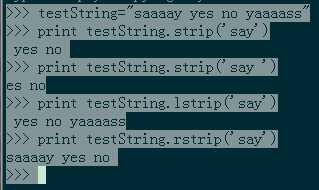标签:
今天在做角色控制中,有一个地方用到rstrip,判断用户请求的url是否与数据库对应可用权限中url相符。
if request.path == x.url or request.path.rstrip(‘/‘) == x.url: #精确匹配,判断request.path是否与permission表中的某一条相符
借此机会总结一下python中strip,lstrip和rstrip。
Python中strip用于去除字符串的首位字符,同理,lstrip用于去除左边的字符,rstrip用于去除右边的字符。
这三个参数都可以传入一个参数,指定要去除的首尾字符。
需要注意的是,传入的是一个字符数组,编译器去除两端所有匹配的字符,直到没有匹配的字符,比如:
>>> testString="saaaay yes no yaaaass" >>> print testString.strip(‘say‘) yes no >>>
可见,testString依次被去除首尾在[‘s‘,‘a‘,‘y‘]数组内的字符,直到剩余字符不再数组内。所以输出yes no。
Note:
当没有传入参数时,默认去除首尾空格。
lstrip和rstrip原理一样。
举例:
>>> testString="saaaay yes no yaaaass" >>> print testString.strip(‘say‘) yes no #以空格开头和结尾的
>>> print testString.strip(‘say ‘) es no#开头结尾均无空格 >>> print testString.lstrip(‘say‘) yes no yaaaass#以空格开头 >>> print testString.rstrip(‘say‘) saaaay yes no #以空格结尾 >>>
可以对照编辑器中选中状态的这张图理解

标签:
原文地址:http://www.cnblogs.com/starof/p/4651288.html